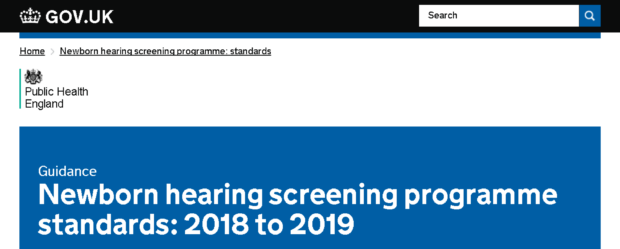It’s important that we continually review performance of the NHS Newborn Hearing Screening Programme (NHSP) so that all newborn babies in England can receive the best quality screening test, with early referral for diagnostic testing.
Our aim is for all babies identified with a permanent childhood hearing impairment to receive care and management at the earliest possible age to help with their communication development.
We recently reviewed the NHSP standards that were originally published in April 2016. We have now agreed and published a new version, with changes to some of the thresholds (or measures). These 2018 to 2019 NHSP standards have an implementation date of 1 April 2018.

The standards provide a set of measures that providers have to meet to make sure local screening services are safe and effective. Data is collected and reported annually against the standards in order to support health professionals and commissioners in providing a high quality programme.
We have removed the glossary from the standards publication and now refer to PHE Screening’s central glossary of terms. If you would like to see the meaning of an acronym in the standards, hover over it with your cursor and you will be able to see the full definition.
We are fortunate to have plenty of good quality data thanks to our national SMaRT4Hearing (S4H) IT system. Using an agreed method set out by the PHE Screening data group, we looked at ranges within the data and used these as a starting point for reviewing the standard thresholds.
Data drives threshold changes
 The thresholds are the level of performance which services are expected to reach to show that newborn hearing screening is safe and effective. We expect local providers to exceed the acceptable threshold and have plans in place towards reaching the achievable level. Those not meeting the acceptable level should have plans in place to show how a rapid improvement will be achieved.
The thresholds are the level of performance which services are expected to reach to show that newborn hearing screening is safe and effective. We expect local providers to exceed the acceptable threshold and have plans in place towards reaching the achievable level. Those not meeting the acceptable level should have plans in place to show how a rapid improvement will be achieved.
As part of the review, we considered issues that can affect the ability of a local service to meet the thresholds. These include variations in clinical practice and the fact that there are now only 8 community-based hearing screening programmes in England, far fewer than when the standards were first published.
The data showed that even in cases where some of the thresholds were not met, there was evidence of a steady year-on-year improvement. Examples include standard 4 (time from screening outcome to offered appointment for diagnostic audiological assessment) and standard 5 (time from screening outcome to attendance at an audiological assessment appointment).
For both these standards the number of local services achieving the acceptable level has increased and we expect this to continue. For standard 4, it rose from 95.3% (2014 to 2015) to 97.5% (Q1 2017 to 2018) and for standard 5 it increased from 86.5% (2014 to 2015) to 89.2% (Q1 2017 to 2018).
The table below summarises the changes to the thresholds.
| Standard | Change |
| 1: identify the population and coverage | Acceptable level from ≥97.0% to ≥98.0% |
| 2: test performance hospital referral rate at automated otoacoustic (AOAE1) (well babies) | Acceptable level from ≤30.0% to ≤27.0%
Achievable level from ≤25.0% to ≤22.0% |
| 3: test performance hospital referral rate to diagnostic audiological assessment | Achievable level from ≤2.5% to ≤2.0% |
We will complete a detailed review of the standards between 1 April 2018 and 31 March 2019 as part of the 3-yearly review cycles when standards may be changed or new ones added.
We will shortly publish a report of some annualised data for NHSP, so keep an eye out for that.
PHE Screening blogs
PHE Screening blogs provide up to date news from all NHS screening programmes. You can register to receive updates direct to your inbox, so there’s no need to keep checking for new blogs.